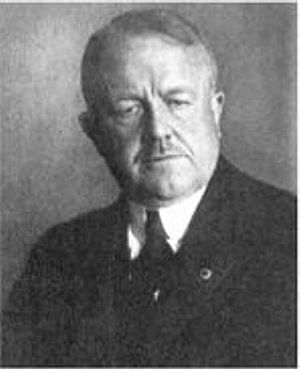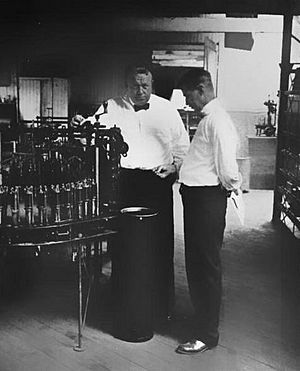Frank Bunker Gilbreth facts for kids
Quick facts for kids
Frank Bunker Gilbreth
|
|
|---|---|

Frank Bunker Gilbreth
|
|
| Born | July 7, 1868 Fairfield, Maine, U.S.
|
| Died | June 14, 1924 (aged 55) Montclair, New Jersey, U.S.
|
| Occupation |
|
| Known for | Time-motion study |
| Spouse(s) | |
| Children | 12, including Ernestine, Frank Jr., and Robert |
Frank Bunker Gilbreth (July 7, 1868 – June 14, 1924) was an American engineer and consultant. He is famous for his work in scientific management. He also helped create the idea of time and motion study. You might know him best as the father and main character in the book Cheaper by the Dozen.
Frank and his wife, Lillian Moller Gilbreth, were both industrial engineers. They were experts in making work more efficient. They studied how people work to find better ways to do things.
Contents
Biography
Early Life and Education
Frank Gilbreth was born in Fairfield, Maine, on July 7, 1868. He was the third child and only son. His mother, Martha, was a schoolteacher. His father, John, owned a hardware store. Frank's father died suddenly when Frank was only three years old.
After his father's death, his mother moved the family to Andover, Massachusetts. She wanted to find better schools for her children. Sadly, the family's money was lost or stolen. Martha had to find a way to earn a living. She moved the family to Boston for good public schools. She opened a boarding house to support them.
Frank was not a great student at first. He went to Rice Grammar School. His mother even taught him at home for a year. Later, he attended Boston's English High School. His grades got better when he found an interest in science and math. He passed the entrance exams for the Massachusetts Institute of Technology. But he decided to work instead of going to college. He wanted his mother to be able to close her boarding house.
Starting His Career in Construction
Renton Whidden, Frank's old Sunday School teacher, hired him. Frank started at Whidden Construction Company in July 1885. He was 17 years old. His job was to start as a laborer and learn all the building trades.
As a bricklayer's helper, he noticed something important. Different bricklayers used different methods. Some were much faster than others. This made him want to find "the one best way" to do any task. He quickly learned all about building and contracting. He also took night classes to learn mechanical drawing. After five years, he became a superintendent. This allowed his mother to finally close her boarding house.
Frank used his observations to invent new tools. He developed a special scaffold for bricklayers. It kept bricks easy to reach. He also patented a "Vertical Scaffold" and a "Gilbreth Waterproof Cellar." He even made improvements in concrete construction. After ten years, at age 27, he was the chief superintendent. He left the company to start his own business.
Frank Gilbreth, General Contractor
On April 1, 1895, Frank started his own construction company. It was called "Frank B. Gilbreth, General Contractor." Over the next 15 years, his company built about 100 large projects. These included factories, paper mills, canals, and powerhouses. Most were in the United States, with a few in Canada.
One big project was the Simmons Hardware Company's warehouse in Sioux City. It needed hundreds of concrete piles to support the heavy building. Frank used his "Time and Motion" ideas for this project. He made sure the bricklaying and material transport were very efficient. The building was also designed to easily handle deliveries by train.
Frank was also an inventor. He held 13 patents for his ideas. He even had offices in London and Berlin for his patents.
Becoming an Efficiency Expert
Around 1912, Frank changed his career. He stopped building and became an expert in efficiency and management. He even became a guest lecturer at Purdue University.
Frank first thought about efficiency when he was a young construction worker. He always looked for ways to make tasks faster and easier. This interest grew into a partnership with his wife, Lillian Moller Gilbreth. They studied how people worked in factories and offices. Their goal was to increase output and make jobs easier for workers. They started a company called Frank B. Gilbreth, Inc.
Family Life
Frank married Lillian Evelyn Moller on October 19, 1904. They were married in Oakland, California. Frank and Lillian had 12 children! Their names were Anne, Mary, Ernestine, Martha, Frank Jr., William, Lillian, Frederick, Daniel, John, Robert, and Jane. They also had a daughter who was stillborn.
His Death
Frank Gilbreth died on June 14, 1924. He was 55 years old. He had a heart attack while talking to his wife on the phone. He was at the Lackawanna Terminal in Montclair, New Jersey. Lillian lived for 48 more years after Frank's death.
Frank Gilbreth's Work
Motion Studies
During World War I, Frank Gilbreth served in the U.S. Army. He was a major. His job was to find faster ways to put together and take apart small weapons. However, he got sick with rheumatic fever and pneumonia. This happened just weeks after he started serving. He spent four months recovering. The damage to his heart from this illness contributed to his early death six years later.
Frank Gilbreth studied every tiny movement of a hand. He broke down all hand motions into 17 basic parts. These included actions like grasping, moving something, and holding. He called these basic motions "therbligs." This word is "Gilbreth" spelled backward, with the "th" swapped. He used a special movie camera to time these small motions. This camera could measure fractions of a minute.
The Gilbreths believed in finding "the one best way" to do things. Their work helped people understand that repeated motions can cause injuries.
Frank also came up with the idea of a "caddy" for surgeons. This person would hand surgical instruments to the surgeon as needed. He also created the standard ways armies teach recruits to quickly take apart and put together weapons. Soldiers can even do this blindfolded or in the dark.
Scientific Management Ideas
The work of Frank and Lillian Gilbreth is often linked to Frederick Winslow Taylor. But the Gilbreths had a different idea about how to improve work. Taylor focused on using a stopwatch to make tasks faster. He wanted to reduce the time it took to do things.
The Gilbreths, however, wanted to make work more efficient by reducing unnecessary motions. They cared more about the workers' well-being. Workers often felt that Taylor's methods were only about making more money. This difference caused some disagreements between Taylor and the Gilbreths. Even after Taylor died, there was still some tension. Lillian Gilbreth later tried to fix these issues.
Studying Fatigue
Frank and Lillian used their Motion Study method to look at work. They found that reducing unnecessary movements was key to efficiency. They also realized that some motions caused workers to get tired.
To reduce tiredness, they worked on several things. They tried to reduce motions, redesign tools, and change where parts were placed. They also looked at the height of benches and seating. Their efforts helped create modern ideas about ergonomics. Ergonomics is the science of designing workplaces and tools to fit people.
Legacy
Frank and Lillian Gilbreth often used their large family for experiments. Their children even wrote a book about their fun family life. The book is called Cheaper by the Dozen (1948). It was written by their son Frank Jr. and daughter Ernestine. This book inspired a movie in 1950. It also inspired two other movies with the same name in 2003 and 2022. These newer movies have families with 12 children, but they are not based on the Gilbreths' real story.
A sequel to the book, Belles on the Toes (1952), tells what happened to the Gilbreth family after Frank's death. The Institute of Industrial and Systems Engineers (IISE) gives an award in Frank and Lillian Gilbreth's honor. It is for people who have achieved a lot in their field.
Frank Gilbreth had a famous saying: "I will always choose a lazy person to do a difficult job, because a lazy person will find an easy way to do it." Many people still use this quote today. Sometimes, it is wrongly thought to be from Bill Gates, but he only repeated it.
See also
 In Spanish: Frank Gilbreth para niños
In Spanish: Frank Gilbreth para niños


